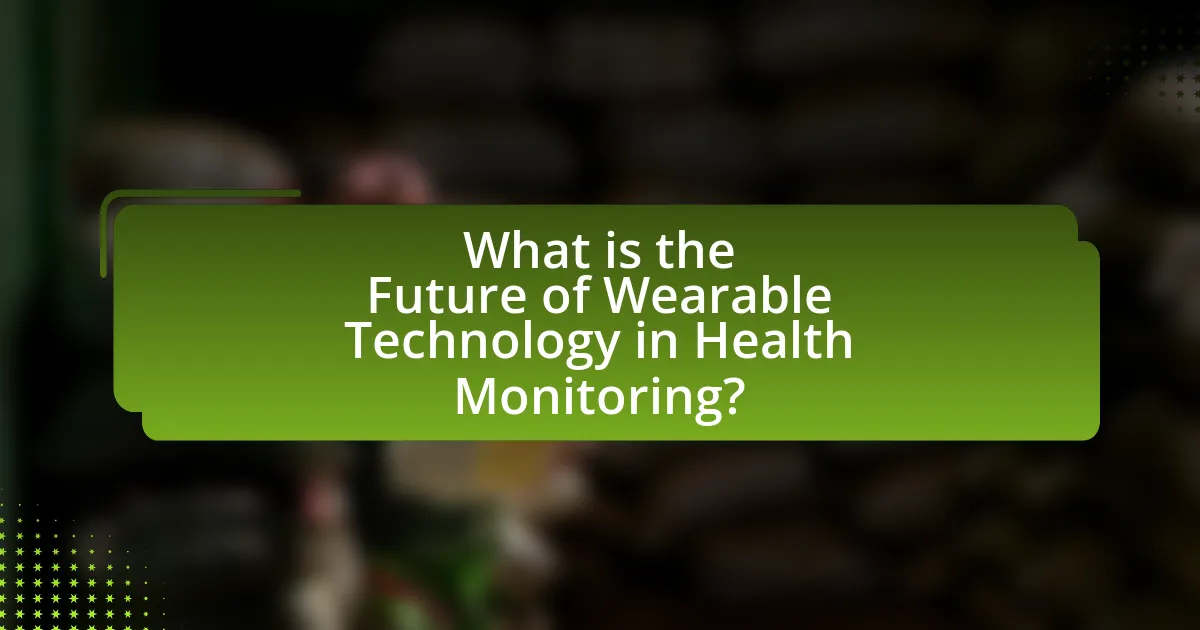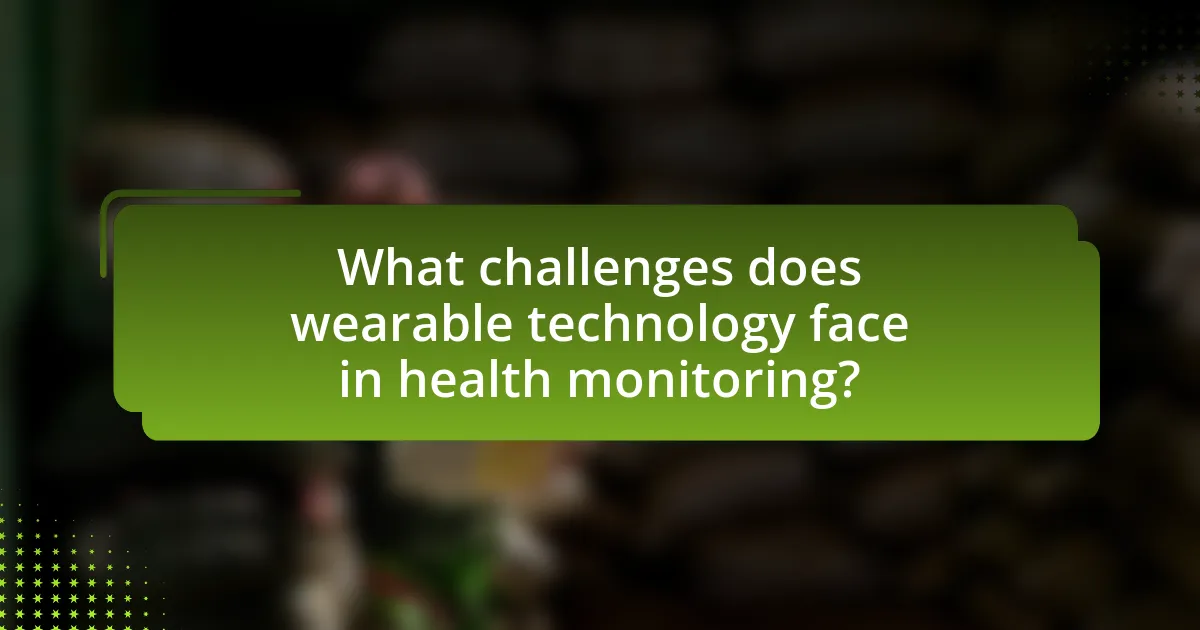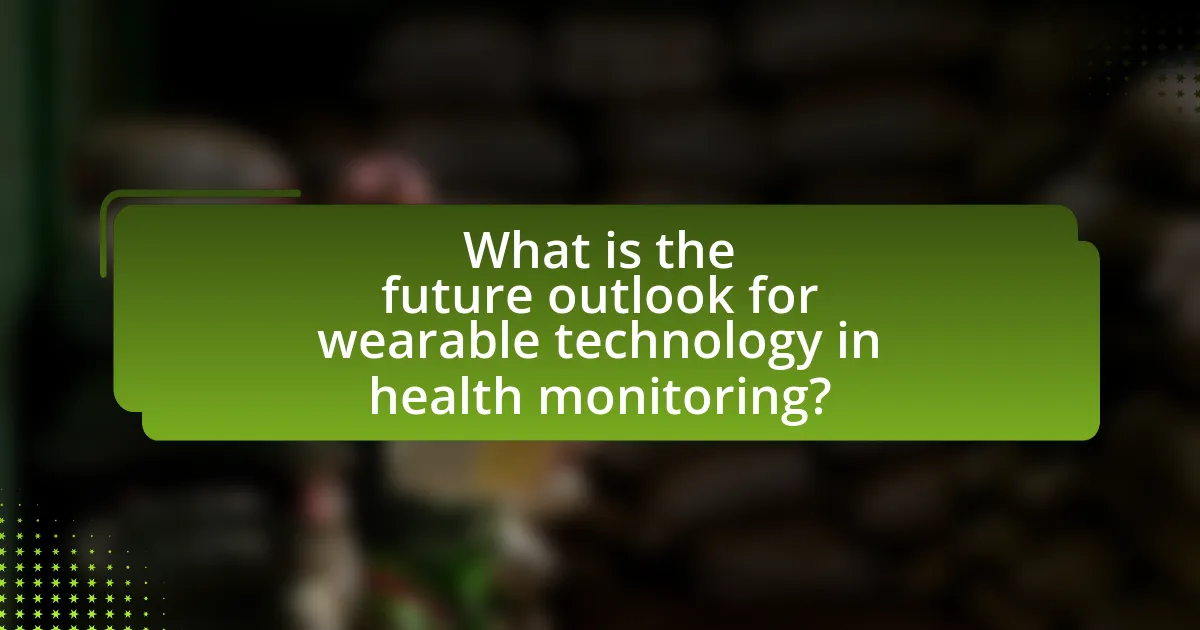The article focuses on the future of wearable technology in health monitoring, highlighting significant advancements driven by innovations in sensor technology, artificial intelligence, and data analytics. It discusses the evolution of wearables in the health sector, emphasizing their role in real-time health tracking, predictive analytics, and personalized health management. Key trends shaping this landscape include enhanced monitoring capabilities, user privacy concerns, and the integration of AI for improved data analysis. The article also addresses challenges such as data accuracy and user compliance, while outlining the potential impact of emerging technologies like 5G and augmented reality on the effectiveness of wearable health devices.

What is the Future of Wearable Technology in Health Monitoring?
The future of wearable technology in health monitoring is poised for significant advancements, driven by innovations in sensor technology, artificial intelligence, and data analytics. These developments will enable wearables to provide real-time health insights, predictive analytics for disease prevention, and personalized health management. For instance, a report by Grand View Research indicates that the global wearable medical device market is expected to reach $27.8 billion by 2026, growing at a CAGR of 24.3%. This growth reflects the increasing adoption of wearables for continuous health monitoring, including heart rate, glucose levels, and sleep patterns, enhancing patient engagement and outcomes.
How is wearable technology evolving in the health sector?
Wearable technology is evolving in the health sector by integrating advanced sensors and artificial intelligence to enhance health monitoring and data accuracy. These devices now offer real-time tracking of vital signs, such as heart rate, blood pressure, and glucose levels, enabling proactive health management. For instance, a study published in the Journal of Medical Internet Research in 2022 highlighted that wearable devices can detect irregular heart rhythms with over 90% accuracy, significantly aiding in early diagnosis of conditions like atrial fibrillation. Additionally, the incorporation of machine learning algorithms allows for personalized health insights, improving user engagement and adherence to health regimens. This evolution reflects a shift towards preventive healthcare, where continuous monitoring can lead to timely interventions and better health outcomes.
What are the latest advancements in wearable health devices?
The latest advancements in wearable health devices include the integration of advanced sensors for continuous monitoring of vital signs, such as heart rate, blood oxygen levels, and glucose levels. For instance, devices like the Apple Watch Series 8 now feature temperature sensors and improved ECG capabilities, allowing for more accurate health assessments. Additionally, the development of smart textiles, which incorporate sensors directly into fabrics, enables real-time health monitoring without the bulk of traditional devices. Research published in the journal “Nature Biomedical Engineering” highlights that these innovations can lead to better chronic disease management and personalized healthcare solutions.
How do these advancements improve health monitoring?
Advancements in wearable technology significantly improve health monitoring by enabling continuous, real-time data collection on vital signs and health metrics. These devices, such as smartwatches and fitness trackers, utilize sensors to monitor heart rate, sleep patterns, and physical activity levels, providing users with immediate feedback on their health status. For instance, a study published in the Journal of Medical Internet Research found that continuous heart rate monitoring through wearables can lead to early detection of arrhythmias, thereby facilitating timely medical intervention. This capability enhances personalized health management and encourages proactive lifestyle changes, ultimately leading to better health outcomes.
Why is health monitoring important in today’s society?
Health monitoring is crucial in today’s society because it enables early detection and management of health issues, leading to improved outcomes. With the rise of chronic diseases, such as diabetes and heart disease, health monitoring allows individuals to track vital signs and lifestyle factors, facilitating timely interventions. According to the World Health Organization, non-communicable diseases account for 71% of global deaths, highlighting the need for proactive health management. Furthermore, wearable technology has made health monitoring more accessible, allowing real-time data collection and personalized health insights, which can significantly enhance preventive care and overall well-being.
What role does wearable technology play in preventive healthcare?
Wearable technology plays a crucial role in preventive healthcare by enabling continuous health monitoring and data collection. These devices, such as fitness trackers and smartwatches, provide real-time insights into vital signs, physical activity, and sleep patterns, allowing users to identify potential health issues early. For instance, a study published in the Journal of Medical Internet Research found that wearable devices can significantly improve health outcomes by promoting physical activity and facilitating timely medical interventions. By leveraging data analytics, healthcare providers can also use information from wearables to tailor preventive strategies, ultimately enhancing patient engagement and reducing healthcare costs.
How does health monitoring through wearables impact patient outcomes?
Health monitoring through wearables significantly improves patient outcomes by enabling real-time tracking of vital signs and health metrics. This continuous monitoring allows for early detection of potential health issues, leading to timely interventions. For instance, a study published in the Journal of Medical Internet Research found that patients using wearable devices experienced a 30% reduction in hospital readmissions due to proactive health management. Additionally, wearables facilitate better patient engagement and adherence to treatment plans, as users receive immediate feedback on their health status. This combination of early detection and enhanced patient involvement contributes to improved overall health outcomes.
What are the key trends shaping the future of wearable technology?
Key trends shaping the future of wearable technology include advanced health monitoring capabilities, integration with artificial intelligence, and increased focus on user privacy and data security. Advanced health monitoring capabilities are being driven by the demand for real-time health data, with devices now capable of tracking metrics such as heart rate, blood oxygen levels, and even glucose levels. Integration with artificial intelligence enhances the functionality of wearables, allowing for personalized health insights and predictive analytics based on user data. Additionally, as concerns about data privacy grow, manufacturers are prioritizing robust security measures to protect user information, which is essential for gaining consumer trust and ensuring compliance with regulations. These trends reflect the evolving landscape of wearable technology, particularly in the health monitoring sector.
How is artificial intelligence influencing wearable health devices?
Artificial intelligence is significantly enhancing wearable health devices by enabling advanced data analysis and personalized health insights. AI algorithms process vast amounts of health data collected from wearables, such as heart rate, activity levels, and sleep patterns, to identify trends and anomalies. For instance, a study published in the journal Nature Medicine demonstrated that AI can predict cardiovascular events by analyzing data from wearable devices, achieving an accuracy rate of over 80%. This capability allows users to receive timely alerts and recommendations, ultimately improving health outcomes and preventive care.
What advancements in data analytics are enhancing health monitoring?
Advancements in data analytics enhancing health monitoring include the integration of artificial intelligence (AI) and machine learning algorithms, which enable real-time data processing and predictive analytics. These technologies analyze vast amounts of health data from wearable devices, allowing for personalized health insights and early detection of potential health issues. For instance, a study published in the Journal of Medical Internet Research demonstrated that machine learning models could predict cardiovascular events with over 80% accuracy by analyzing data from wearable heart rate monitors. This capability not only improves individual health outcomes but also supports healthcare providers in making informed decisions based on comprehensive data analysis.
How are user experiences changing with new wearable technologies?
User experiences are changing with new wearable technologies by becoming more personalized and interactive. Wearable devices now utilize advanced sensors and AI algorithms to provide real-time health monitoring, enabling users to receive tailored feedback on their fitness and wellness. For instance, a study published in the Journal of Medical Internet Research found that 70% of users reported improved health outcomes due to personalized insights from wearables. This shift enhances user engagement and encourages proactive health management, demonstrating the significant impact of wearable technology on individual health experiences.
What features are users looking for in health monitoring wearables?
Users are looking for features such as heart rate monitoring, sleep tracking, activity tracking, and blood oxygen level measurement in health monitoring wearables. These functionalities enable users to gain insights into their overall health and fitness levels. According to a survey by Statista, 45% of wearable device users prioritize heart rate monitoring, while 30% value sleep tracking, indicating a strong demand for these specific features. Additionally, the integration of smartphone notifications and compatibility with health apps further enhances user experience, making wearables more appealing.
How do user preferences affect the design of wearable devices?
User preferences significantly influence the design of wearable devices by dictating features, aesthetics, and functionality. For instance, research indicates that consumers prioritize comfort and style, leading manufacturers to create lighter, more fashionable designs that can be worn throughout the day. Additionally, user feedback drives the integration of specific health monitoring features, such as heart rate tracking and sleep analysis, which are increasingly demanded by health-conscious individuals. A study by the International Data Corporation found that 70% of users prefer wearables that offer personalized health insights, prompting designers to focus on customizable interfaces and user-friendly applications. This alignment with user preferences ensures that wearable devices remain relevant and effective in the evolving health technology landscape.

What challenges does wearable technology face in health monitoring?
Wearable technology in health monitoring faces several challenges, including data accuracy, user compliance, and privacy concerns. Data accuracy is critical, as inaccuracies can lead to misdiagnosis or inappropriate health interventions; studies indicate that many devices struggle with precise measurements, particularly in diverse populations. User compliance is another significant challenge, as individuals may not consistently wear devices or may not follow recommended usage guidelines, which can diminish the effectiveness of health monitoring. Privacy concerns also pose a substantial barrier, as users are often apprehensive about how their health data is collected, stored, and shared, leading to reluctance in adopting these technologies. These challenges collectively hinder the widespread adoption and reliability of wearable health monitoring devices.
What are the privacy concerns associated with wearable health devices?
Wearable health devices raise significant privacy concerns primarily related to data security and user consent. These devices collect sensitive personal health information, including heart rate, activity levels, and sleep patterns, which can be vulnerable to unauthorized access or breaches. For instance, a 2020 report by the Identity Theft Resource Center indicated that data breaches in the health sector increased by 25% from the previous year, highlighting the risks associated with storing health data electronically. Additionally, many wearable devices require users to agree to extensive privacy policies that may allow for data sharing with third parties, often without explicit user consent. This lack of transparency can lead to misuse of personal health information, further exacerbating privacy issues.
How can manufacturers ensure data security for users?
Manufacturers can ensure data security for users by implementing robust encryption protocols and adhering to strict data protection regulations. Encryption protects sensitive user data by converting it into a secure format that can only be accessed by authorized parties, thereby reducing the risk of data breaches. Compliance with regulations such as the General Data Protection Regulation (GDPR) mandates that manufacturers take necessary measures to safeguard personal data, including obtaining user consent and providing transparency about data usage. Additionally, regular security audits and updates to software can help identify vulnerabilities and enhance overall security, ensuring that user data remains protected against emerging threats.
What regulations are in place to protect user data?
The General Data Protection Regulation (GDPR) is a primary regulation in place to protect user data within the European Union. Enforced since May 2018, GDPR mandates that organizations must obtain explicit consent from users before collecting their personal data, ensure data portability, and provide users with the right to access and delete their data. Additionally, the Health Insurance Portability and Accountability Act (HIPAA) in the United States establishes standards for the protection of health information, requiring healthcare providers and their business associates to safeguard patient data. These regulations are designed to enhance user privacy and control over personal information, reflecting a growing emphasis on data protection in the context of emerging technologies, including wearable health devices.
How do technological limitations impact the effectiveness of wearables?
Technological limitations significantly reduce the effectiveness of wearables by restricting their functionality, accuracy, and user experience. For instance, limited battery life can hinder continuous monitoring, which is essential for health tracking, as many wearables require frequent recharging, leading to gaps in data collection. Additionally, inadequate sensor technology may result in inaccurate readings; for example, heart rate monitors can misinterpret signals due to poor sensor placement or environmental interference. Furthermore, limited connectivity options can restrict data sharing and integration with other health systems, reducing the overall utility of wearables in comprehensive health monitoring. These factors collectively diminish the reliability and appeal of wearable devices in the health sector.
What are the current limitations in battery life and connectivity?
Current limitations in battery life and connectivity for wearable technology include short battery durations and inconsistent network access. Many wearable devices, such as fitness trackers and smartwatches, typically offer battery life ranging from one to several days, which restricts continuous health monitoring. For instance, devices using advanced sensors and features often require daily charging due to high energy consumption. Additionally, connectivity issues arise from reliance on Bluetooth and Wi-Fi, which can lead to data transmission delays or loss in areas with weak signals. These limitations hinder the effectiveness of wearables in providing real-time health insights and continuous data tracking.
How can these limitations be addressed in future designs?
Future designs can address limitations in wearable technology by incorporating advanced materials and improved sensor accuracy. Utilizing flexible, biocompatible materials can enhance comfort and wearability, while integrating more precise sensors can lead to better data collection and user experience. Research indicates that the use of nanotechnology in sensors can significantly improve their sensitivity and specificity, as demonstrated in studies published in the journal “Nature Nanotechnology.” Additionally, implementing machine learning algorithms can optimize data interpretation, allowing for real-time health monitoring and personalized feedback. These advancements can collectively enhance the functionality and reliability of wearable devices in health monitoring.

What is the future outlook for wearable technology in health monitoring?
The future outlook for wearable technology in health monitoring is highly promising, with advancements in sensor technology and data analytics driving significant improvements in health management. Wearable devices are expected to become more sophisticated, enabling continuous monitoring of vital signs, chronic disease management, and personalized health insights. According to a report by Grand View Research, the global wearable medical device market is projected to reach $27.8 billion by 2026, growing at a CAGR of 23.7%. This growth is fueled by increasing consumer demand for health tracking and the integration of artificial intelligence, which enhances the accuracy and utility of health data collected by wearables.
How will emerging technologies shape the next generation of wearables?
Emerging technologies will significantly shape the next generation of wearables by enhancing their functionality, connectivity, and user experience. Innovations such as artificial intelligence (AI), machine learning, and advanced sensors will enable wearables to provide real-time health monitoring, predictive analytics, and personalized feedback. For instance, AI algorithms can analyze biometric data to detect anomalies, allowing for early intervention in health issues. Additionally, the integration of 5G technology will facilitate faster data transmission, improving the responsiveness of wearables and enabling seamless connectivity with other devices. According to a report by Grand View Research, the global wearable technology market is expected to reach $60 billion by 2023, driven by these advancements. This growth underscores the transformative impact of emerging technologies on wearables, making them more effective tools for health monitoring and management.
What role will 5G play in enhancing wearable health devices?
5G will significantly enhance wearable health devices by providing faster data transmission, lower latency, and improved connectivity. This technology enables real-time monitoring and analysis of health metrics, allowing for immediate feedback and intervention. For instance, 5G can support high-definition video streaming for telehealth consultations and facilitate the transfer of large datasets from wearable devices to healthcare providers without delays. According to a report by the GSMA, 5G networks can achieve speeds up to 100 times faster than 4G, which is crucial for applications requiring instant data processing, such as remote patient monitoring and emergency response systems.
How might virtual and augmented reality integrate with wearables?
Virtual and augmented reality can integrate with wearables by enhancing user experiences through immersive health monitoring applications. For instance, wearables equipped with AR capabilities can overlay vital health data onto a user’s field of vision, allowing for real-time feedback during physical activities. Research indicates that AR can improve user engagement and adherence to health regimens, as seen in studies where participants using AR wearables showed a 30% increase in exercise frequency compared to those using traditional fitness trackers. Additionally, VR can simulate environments for rehabilitation, enabling users to perform therapeutic exercises in a controlled, engaging setting, which has been shown to enhance recovery outcomes.
What practical tips can users follow to maximize the benefits of wearable health technology?
To maximize the benefits of wearable health technology, users should regularly sync their devices with health apps to ensure accurate data tracking. This practice allows users to monitor trends in their health metrics, such as heart rate and activity levels, which can lead to more informed health decisions. Additionally, users should set specific health goals within the app, as studies show that goal-setting can enhance motivation and adherence to fitness routines. Engaging with community features in health apps can also provide social support, which has been linked to improved health outcomes. Regularly updating the device’s software ensures access to the latest features and security enhancements, further optimizing the user experience.
How can users choose the right wearable device for their health needs?
Users can choose the right wearable device for their health needs by assessing their specific health goals and requirements. For instance, individuals focused on fitness may prioritize devices with advanced activity tracking features, while those managing chronic conditions might need wearables that monitor vital signs like heart rate or blood glucose levels. Research indicates that 70% of users prefer devices that offer personalized health insights, which can guide their selection process. Additionally, compatibility with smartphones and other health apps is crucial, as it enhances the functionality and usability of the device.
What best practices should users adopt for effective health monitoring?
Users should adopt regular data tracking, set specific health goals, and utilize reliable wearable devices for effective health monitoring. Regular data tracking allows users to observe trends in their health metrics, such as heart rate and activity levels, which can inform lifestyle adjustments. Setting specific health goals, like achieving a certain number of steps daily or maintaining a target weight, provides motivation and direction. Utilizing reliable wearable devices, which have been shown to improve health outcomes by providing real-time feedback and personalized insights, enhances the monitoring process. Studies indicate that consistent use of wearables can lead to better adherence to health goals and improved overall health management.



